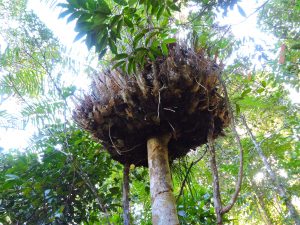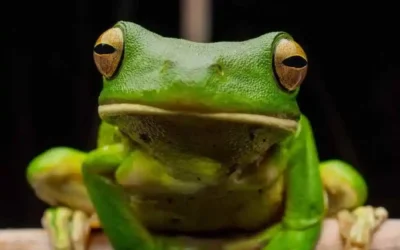Deciduous trees in Barron Gorge
Deciduous trees, means that they lose all their leaves just before winter arrives.
People from temperate countries in Europe and North America are generally used to their trees being predominantly deciduous.
This makes sense as there is little available water, warmth and light during the northern winters. The exceptions are the northern conifers, they are evergreens throughout the year. This is largely thanks to their needles, specially modified leaves adapted to cold winters by being narrow and filled with anti-freeze. This is achieved by the leaves either rolling up, or the midrib swelling up.
However in Australia, this is bizarrely not the case. Australia has very few deciduous trees. No matter what time of year it is, Australian trees generally keep their leaves year round with the occasional exception.
The exceptions are mostly found in the sub-tropics and tropics with one notable exception, the Deciduous Beech from Tasmania. The reason for this peculiar feature of Australia has to do with the variable and downright unpredictable weather of this country. In the Outback, rain is very unpredictable and any tree that drops its leaves will be at a huge disadvantage should there be rain while they have no leaves to take advantage of it! Having leaves is of course costly, but Australian trees in the outback compensate for this in two ways.
First our soils may be low in nutrients but they are deep and usually lay over aquifers underground. So our outback trees often have exceptionally long roots. Secondly, our outback trees have droopy leaves and angle them in such a way as to avoid too much evaporation when exposed to the sun. In the coastal tropics, this holds as well but here we have a distinct dry Season as opposed to an equally distinct Wet Season. This has allowed some of our trees to be deciduous. Interestingly the few deciduous trees we have in the rainforest do not necessarily lose their leaves and re-grow them when you think they would.

Red Cedar was once a very common tree in New South Wales and Queensland rainforests along rivers and creeks. Sadly the beautiful red timber was easy to work and was highly valued. It was so popular for a while that it became known as Red Gold thanks to the money the loggers made from the lucrative timber trade of this tree. Red Cedar was known to have buttresses up to 5 metres tall, forcing the loggers to put in wooden steps above the buttresses which the loggers stood on while sawing.
Thanks to this tree’s susceptibility to tip moth borers, Red Cedar is unsuitable for plantations. When grown in plantation conditions the trees initially grow well until the tip moth strikes en masse, stunting the juvenile trees growth and rendering the timber useless. Red Cedar has tiny flowers and the fruits are tiny woody capsules full of papery seeds.
White Cedar is a close relative of the Red Cedar and has a beautiful timber that produces planks that don’t crack or warp when dried and are resistant to fungal infection. The timber is, however, under-utilised due to the rarity of sufficiently large specimens for logging. The lilac coloured flowers are quite distinct and are followed by yellow berries that are very popular with local birds but toxic to humans. The leaves are compound with serrated leaflets.
Damson is the most obvious of our deciduous trees. Damson has an unusual kind of branching where the tip dips down before producing a fan of branches that again dip down and spread out. This makes these trees very messy. The flowers are borne on small spikes with male flowers toward the tip and flowers toward the base. The flowers have a quite pungent odour that makes them unmistakable. The fruits are hairy or smooth purple or blue drupes that attract numerous birds. The fruits are produced several times a year and the timber is occasionally used for constructional purposes.

Figs are without a doubt the most important trees in the rainforest due to their tendency to fruit year round. In this respect they can be considered keystone species. Some fig species are what we call strangler figs, with some of these again becoming banyans. These figs often start life on top of a tree, typically being deposited in a Basket Fern full of compost.
These figs are initially epiphytes before sending their roots down the side of their host tree and into the ground. Over time, the roots fuse together, restricting the growth of the unfortunate host tree that often ends up dying. If the fig is strong enough it becomes the new canopy tree on that spot. If not, it topples over and a gap in the canopy is created.
The flowers are produced inside a special structure known as a head. As all figs have separate sexes, special fig wasps are responsible for pollinating these flowers and some of the flowers, known as gall flowers, are reserved for wasp eggs. The head turns into what we think of as the fruit. In the case of banyans, the strangler fig sends out roots to neighbouring trees and kills each of these in turn. Banyans can cover quite large areas when of a certain age.
In India such large banyans are considered sacred. Check out the impressive Strangler Fig at Red Peak Station during your Skyrail Rainforest Cableway experience and the many basket ferns dotted along the forest canopy.
Australian Rainforest facts provided by Skyrail Environmental Ranger Tore Lien Linde. Featured image leaf falling in the rainforest by @VisionWalks via Instagram.



